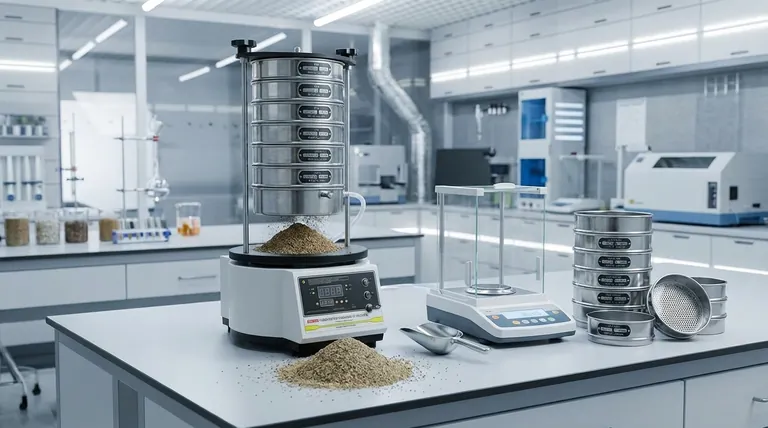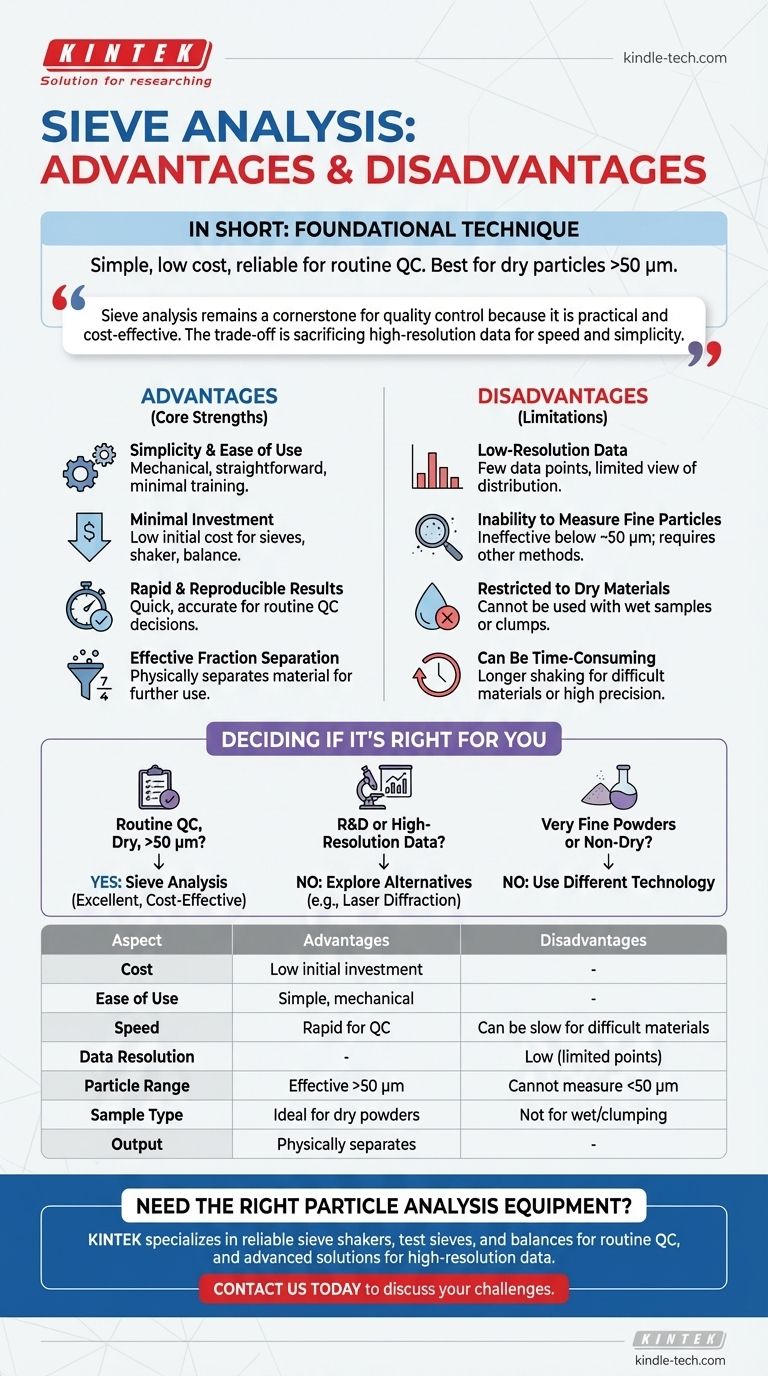In short, sieve analysis is a foundational technique valued for its simplicity, low cost, and reliable results, making it ideal for routine quality control. However, its primary disadvantages are its low resolution, its inability to measure very fine particles (below ~50 µm), and the requirement that all samples must be dry.
Sieve analysis remains a cornerstone of particle sizing for quality control because it is practical and cost-effective. The critical trade-off is sacrificing high-resolution data for operational speed and simplicity.

The Core Strengths of Sieve Analysis
Sieve analysis is one of the most traditional and widely used methods for measuring particle size distribution for a reason. Its advantages lie in its practicality and reliability for many industrial applications.
Simplicity and Ease of Use
The process is mechanical and straightforward, requiring minimal specialized training to perform accurately. It involves shaking a sample through a stack of sieves with progressively smaller mesh sizes.
Minimal Investment
Compared to more advanced particle analysis techniques like laser diffraction, the initial cost for sieves, a shaker, and a balance is very low. This makes it an accessible option for almost any operation.
Rapid and Reproducible Results
For many materials, the test provides accurate and repeatable results in a relatively short time. This speed makes it highly effective for quality control where quick decisions are necessary.
Effective Fraction Separation
The method doesn't just measure particle size; it physically separates the material into different size fractions. These separated fractions can then be used for further analysis or other purposes.
Understanding the Trade-offs and Limitations
While effective, the method has clear limitations that make it unsuitable for certain applications. Understanding these drawbacks is key to knowing when to choose an alternative.
Low-Resolution Data
A standard stack of test sieves typically has a maximum of eight sieves. This means the resulting particle size distribution curve is based on only a few data points, offering a low-resolution view of the material's characteristics.
Inability to Measure Fine Particles
The physical limitations of woven-wire mesh mean that sieve analysis is generally not effective for particles smaller than about 50 micrometers (µm). Finer powders require more advanced analytical methods.
Restricted to Dry Materials
The technique relies on the free flow of particles through the sieve mesh. It is fundamentally designed for dry, free-flowing powders and cannot be used with wet samples, slurries, or materials that clump with moisture.
Can Be Time-Consuming
While often described as fast, the process can become time-consuming if the material is difficult to sieve or if a very high degree of precision is required, demanding longer shaking times.
How to Decide if Sieve Analysis is Right for You
Choosing the correct particle analysis method depends entirely on your specific goals and the nature of your material.
- If your primary focus is routine quality control for dry materials >50 µm: Sieve analysis is an excellent, cost-effective, and reliable choice.
- If your primary focus is research and development or requires high-resolution data: You should explore alternative methods like laser diffraction that provide a more detailed particle size distribution.
- If your primary focus is analyzing very fine powders or non-dry samples: Sieve analysis is not suitable, and you must use a different technology.
Ultimately, selecting the right analytical tool is the first step toward achieving meaningful and actionable quality control data.
Summary Table:
| Aspect | Advantages | Disadvantages |
|---|---|---|
| Cost | Low initial investment | - |
| Ease of Use | Simple, mechanical process | - |
| Speed | Rapid results for QC | Can be slow for difficult materials |
| Data Resolution | - | Low (limited data points) |
| Particle Size Range | Effective for particles >50 µm | Cannot measure fine particles (<50 µm) |
| Sample Type | Ideal for dry, free-flowing powders | Not suitable for wet or clumping samples |
| Output | Physically separates fractions | - |
Need the right particle analysis equipment for your lab?
Sieve analysis is a cornerstone of quality control, but selecting the correct method is crucial for accurate results. KINTEK specializes in lab equipment and consumables, providing reliable sieve shakers, test sieves, and balances for your routine QC needs. We also offer solutions for more advanced techniques when high-resolution data is required.
Let our experts help you choose the perfect tool for your application. Contact us today to discuss your particle sizing challenges and ensure you get meaningful, actionable data.
Visual Guide

Related Products
- Laboratory Test Sieves and Vibratory Sieve Shaker Machine
- Laboratory Vibratory Sieve Shaker Machine for Dry and Wet Three-Dimensional Sieving
- Three-dimensional electromagnetic sieving instrument
- Laboratory Vibratory Sieve Shaker Machine Slap Vibrating Sieve
- Laboratory Wet Three-Dimensional Vibratory Sieve Shaker Machine
People Also Ask
- Why is a precision vibratory sieving system important for Pt/Pd alloy analysis? Ensure Data Integrity & XRD Accuracy
- What are the advantages and disadvantages of sieve analysis? A Guide to Cost-Effective Particle Sizing
- What can be separated by sieving? A Guide to Particle Size Separation for Various Materials
- Can sieving be used to separate a solid substance from a liquid substance? Learn the Right Technique for Your Mixture
- Why is a laboratory electromagnetic vibratory sieve shaker used? Optimize Walnut Shell Chemical Pretreatment



















